Acer Predator Triton 500 SE (PT516-52s model – Core i9, RTX 3080Ti)
This article gathers my impressions of the 2022 Predator Triton 500 SE series, Acer’s portable premium laptop meant for professionals, creatives, and gamers.
Unlike most other Predator computers, the Triton 500 SE is a sleeper design, a clean and refined device that doesn’t scream out its capabilities in any way.
Despite that, it does pack powerful specs inside its chassis (with an Intel 12th gen i9 and an RTX 3080Ti in this tested variant), a 16-inch wide-gamut display, good inputs, and excellent connectivity, as well as a 99 Wh battery. Paired with the sturdy construction and clean aesthetics, all these are reasons why I consider the Triton to be a well-balanced premium product that should cater to a wide range of potential buyers.
The devil is always in the details, though, so there are some quirks that you’ll have to be aware of when going with one of these, such as the fact that it does run hot internally and loud on the higher-performance profiles, or the fact that Acer haven’t updated the audio quality in any way from the previous generation.
We’ll get in-depth on all these, and all the other important aspects that you should be aware of when shopping for a 2022 Triton 500 SE, in the detailed review down below.
Mục Lục
Specs as reviewed– Acer Predator Triton 500 SE 2022
Acer Predator Triton 500 SE PT516-52s gaming laptop
Screen
16 inch, 16:10, QHD+ 2560 x 1600 px resolution, IPS, 240 Hz, matte, BOE NE16QDM-NY1 panel
Processor
Intel Alder Lake Core i9-12900H, 6C+8c/20T
Video
Intel UHD and up to Nvidia GeForce RTX 3080Ti 8GB 80-105W
with MUX, Advanced Optimus, and GSync
Memory
32 GB DDR5-4800 (2x DIMMs)
Storage
2x 2 TB PCIe gen4 SSDs, 2x M.2 gen4 slots
Connectivity
WiFi 6E (Killer AX1675i) with Bluetooth 5.2, Killer E3100G 2.5 Gigabit Ethernet LAN
Ports
left: power plug, LAN, 1x USB-A 3.2 gen2, 1x USB-C with Thunderbolt 4, headphone/mic
right: Kensington Lock, HDMI 2.1, 1x USB-C with Thunderbolt 4, 1x USB-A 3.2 gen2,SD 7.0 card reader
Battery
99 Wh, 230 W power adapter
Size
359 mm or 14.1” (w) x 262 mm or 10.3” (d) x 19.9 mm or .78” (h)
Weight
2.3 kg (5.07 lb), .75 kg (1.65 lbs) power brick+cables , EU version
Extras
RGB backlit keyboard – 3 zones, 2x stereo speakers, HD webcam, finger sensor
Expect this to be available in a couple of different configurations, with 3060/3070Ti GPU options and various amounts of RAM/storage.
Design and exterior
The construction and design of 2022 Triton 500 SE are almost identical to the 2021 generation, with only a minimal change on the lid, where the Predator logo has been moved to the top-middle part and is no longer on a small plaque in the corner. I kind of liked the previous lid better, but this one is fine as well.

Compared to other ultraportable designs such as the Razer Blade or Asus Zephyrus or the MSI Stealth, this Triton 500 is a little larger and heavier, at 5.1 lbs. It does compensate for it with the 99Wh battery inside, the sturdy feel of the chassis, and the uncompromised IO. The only other A-brand option that kind of goes the same path these days is the Gigabyte Aero 16 series.
As far as the looks go, I already mentioned this is a clean design with subtle branding, so once you peel off the stickers plastered on the arm-rest and bottom bezel, this should have no problem getting accepted in even the stricter of work/school environments.
Metal alloys are used for the entire chassis, in this dark-gray matte finishing that feels good to the touch and does an excellent job at hiding smudges. You’ll rarely have to wipe this clean, unlike most of the alternatives out there, and the only parts that are showing some smudges are the blacks keycaps.
As far as practicality goes, I appreciate the blunted corners and edges, but there’s still a sharp edge on the underside, where the bottom panel attaches to the main chassis. That part is sharp and you’ll feel it when picking up this laptop.
I’m also a fan of Acer including 16:10 screens on this series, without sacrificing the camera at the top. No IR, though, just a finger-sensor integrated into the clickpad. The two hinges allow to easily adjust and lift up the screen with a single hand, as well as allow it to go back flat to 180-degrees, something I also much appreciate on a portable computer.
On the other hand, Acer could have put grippier rubber feet on this laptop, and should have not placed the status LEDs under the screen. They used to have those on the side on the previous-gen Tritons, but now they’re back in the line of sight, where you’ll see them while using the laptop at night.
The thermal design is something else that we need to discuss here. Air goes into the fans through the grills at the top of the keyboard and through the intakes on the underside, and is then pushed out on the back and on the sides, out of the way and not into the screen, as on other notebooks in this class. This design does result in the keyboard being moved a little down on the chassis, leading to a more cramped arm-rest, in order to allow for those grills at the top. I’m OK with this small drawback, though.
As for the IO, that’s lined in the middle of both edges. There’s everything you will need on this laptop, including 2x USB-C Thunderbolt 4 ports, one on each side, a fast SD card reader, and an HDMI 2.1 port. The HDMI port is connected to the Nvidia dGPU, while the Thunderbolt ports are connected to the Intel iGPU, based on my experience with this unit. Take this with a grain of salt, though, and I’ll explain why further down in the Hardware section.
All in all, this Predator Triton 500 SE is one of the better-balanced designs in the premium niche. It’s a bit larger and heavier than the competition and lacks certain features such as up-firing speakers or a IR camera, but everything else is just about right. Except for those annoyingly placed status LEDs!
Keyboard and trackpad
The keyboard on this laptop is a rather standard Acer layout, with smooth rubbery black keycaps and their custom font on each key. I like the full-sized arrows, even if they are somewhat squeezed among the other keys and not spaced out in any way.
I’m not a big fan of having media keys in the very right column instead of having dedicated keys for Home/End, though, but you can remap them in software if you want to. Given how Acer position this product towards professional users and less so towards gamers, I was hoping they’d also steer the keyboard’s functionality in the same direction.
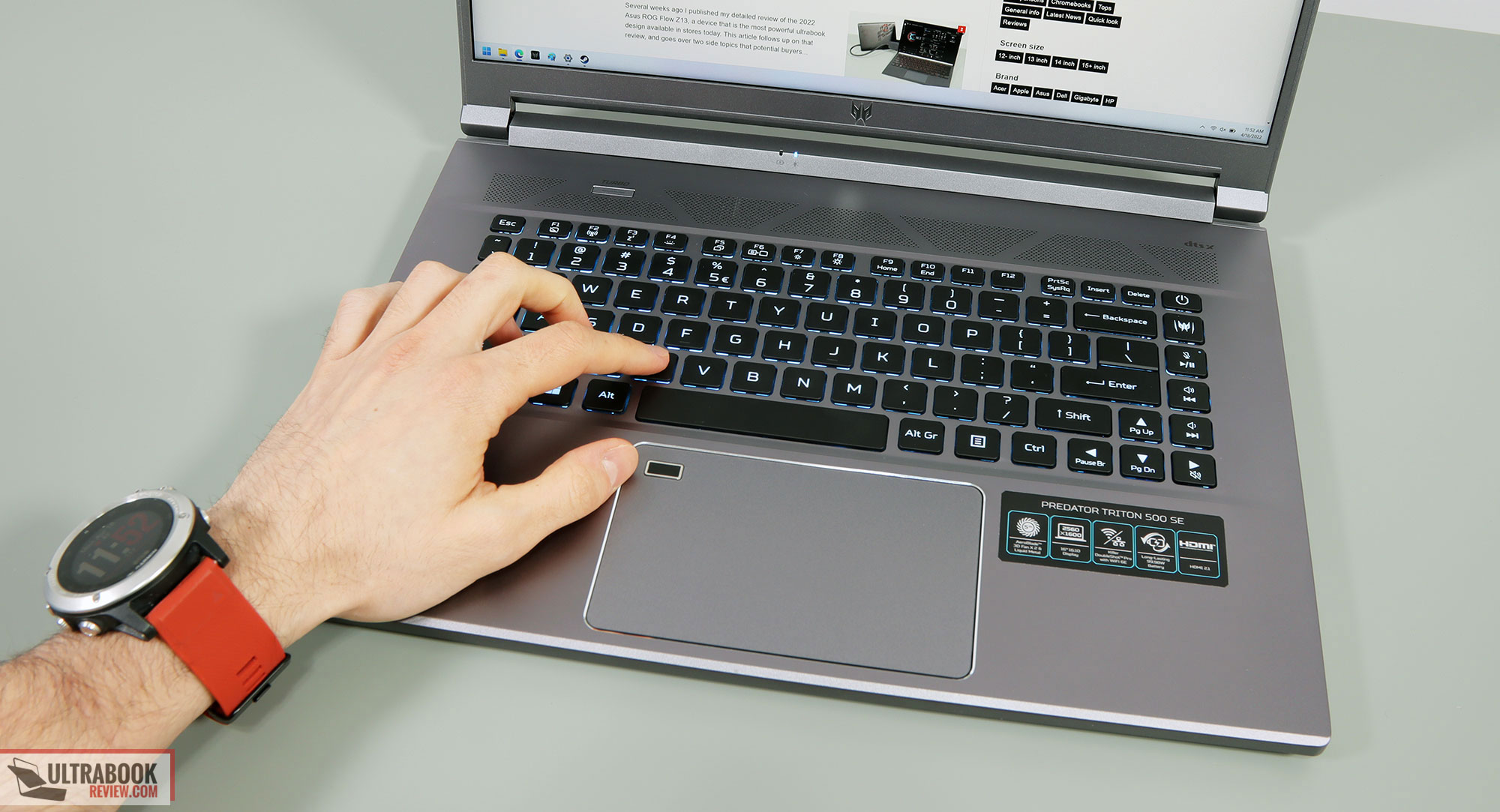
The overall feedback of this keyboard is somewhat on the shallower side, which I find OK, but might not be appreciated by everyone. This is nonetheless a quick and quiet type, one I got along well once I got accommodated to the feedback.
For the illumination, this is a 3-zone lit keyboard with two-light intensity levels to choose from. The LEDs are bright enough and fairly uniform, but a lot of light creeps out from under the keycaps and there’s no option to reactivate the lighting with a swipe over the clickpad once it times off, you have to press a key for it. There’s also the option to disable the 30s time-out from the Predator Sense app, if you want to.
On the plus side, this layout includes a dedicated light indicator for Caps Lock, which Acer keyboards lacked in the past.
The clickpad is glass and is wider than on the 2021 generation, even if still not very tall as a result of the keyboard being placed in the middle, leaving room for the air intakes at the top. It also felt smoother to the touch than on the 2021 Triton.
I have nothing to complain about my experience with this clickpad. It handled everything just right, didn’t rattle with taps and even the physicals clicks were smooth and quiet.
For biometrics, there’s a finger-sensor integrated into the clickpad, in its top-left corner. It works OK with Hello, and I like that there’s no dead-zone when moving your finger or tracking over this finger-sensor.
Screen
There’s a 16.1-inch 16:10 matte display on the 2022 Triton 500, and what we have on our sample is the better panel option available for this series. That’s a QHD+ 3ms 240Hz IPS option with 10-bit color and 100% DCI-P3 gamut coverage, as well as around 500-nits of peak brightness.
To put it simply, this is an wesome panel for daily use, professional use, and gaming. It even supports GSync, which few other devices in this segment do anymore. You might need to calibrate it, though.
Here’s what we got in our tests, with a X-Rite i1 Display Pro sensor:
- Panel HardwareID: BOE BOE0AB5 (NE160QDM-NZ2);
- Coverage: 99.8% sRGB, 82.9% AdobeRGB, 99.0% DCI P3;
- Measured gamma: 2.10;
- Max brightness in the middle of the screen: 483.33 cd/m2 on power;
- Min brightness in the middle of the screen: 21.79 cd/m2 on power;
- Contrast at max brightness: 1234:1;
- White point: 7000 K;
- Black on max brightness: 0.39 cd/m2;
- PWM: No.
Further calibration is required to correct the skewed White Point and Gamma. Even with the calibration, though, our tool recorded some DeltaE imbalances in one of the corners, but the luminosity uniformity came out very good and we hardly noticed any light bleeding around the edges on a black screen.
There might be a few other display options available for this series, but I don’t have all the info at this point.
Hardware and performance
Our test model is the top-specced configuration of the 2022 Acer Predator Triton 500, code name PT516-52s, built on an Intel Core i9-12900H processor, 32 GB of DDR5-4800 memory in dual channel, 2 TB of fast SSD storage, and dual graphics: the Nvidia RTX 3080Ti dGPU with 16 GB of vRAM and the Iris Xe iGPU integrated within the Intel processor.
Disclaimer: Before we proceed, keep in mind that our review unit was sent over by Acer and it runs on the early software available as of early-April 2022 (BIOS v1.04, Predator Sense 3.00.3186, GeForce Game Ready 512.15 drivers). Some aspects can change with later software.
Spec-wise, the 2022 Acer Predator Triton 500 is built on the latest Intel and Nvidia hardware available to date. The Core i7-12900H is a higher-tier Intel Alder Lake 12th-gen processor, with 14 Cores and 20 Threads. It is a hybrid CPU with 6 High-Performance HyperThreaded Cores, and 8 extra Efficiency cores, working together or separate based on demand. The design of this Triton 500 allows the processor to run at up to70W of sustained power in demanding CPU loads, on the Turbo profile.
For the GPU, the 2022 Triton 500 series is available with RTX 3000 and RTX 3000 Ti graphics chips. What we have on this sample is an RTX 3080Ti running at up to 105W with Dynamic Boost in supported games and applications.
There’s also a MUX on the Triton 500 SE series, with Advanced Optimus – Dynamic Display Switching and GSync support on most configurations.
For the RAM and storage options, the laptop offers two accessible memory DIMMs and two M.2 SSD slots. Our unit shipped with 32 GB of DDR5-4800 RAM in dual-channel and two fast PCIe gen4 Samsung SSDs in Raid0.
Acer are still using an inverted internal design with this 2022 updated, which means the SSD and RAM slots are placed underneath the motherboard, so you’d have to disassemble the whole thing to get to them. This makes potential upgrades difficult on this laptop.
Getting inside to the motherboard is an easy job, as you have to take out the bottom panel held in place by a couple of Torx screws, but that won’t help you much when all the slots are underneath. The WiFi chip (no longer an M.2 format as on the 2021 model), speakers, and battery are the only parts easily accessible. This video further explains how to remove the motherboard and get to the components.
Specs aside, the Predator Helios 300 is controllable through the included Predator Sense application, which allows access to power profiles, battery, keyboard, and audio settings. There’s also an Acer Care app that handles updates, as well as a handful of other software – bloatware that comes preinstalled.
The power profiles are Quiet, Default, Extreme, and Turbo, and they impact the fans’ behavior and the CPU/GPU power limits, as well as add a GPU overclock on Extreme/Turbo.
For daily use, I’d keep the laptop on Quiet or Default, which keep the laptop snappy and the fans mostly idle, or very quiet.
Performance and benchmarks
On to more demanding loads, we start by testing the CPU’s performance by running the Cinebench R15 test for 15+ times in a loop, with a 1-2 seconds delay between each run.
I’m not going to get into as many details as in our other reviews, though, because this sample doesn’t work at the best of its abilities with the current pre-release software and BIOS available at this point. I’ll explain why down below.
So, on the Extreme setting, the PL1/PL2 settings for the Core i9-12900H processor are 110W/115W on this laptop. However, the CPU cannot run at those power levels in sustained loads. In fact, it stabilizes at around 65W on the Extreme power profile and 70W on Turbo, both being thermally limited to this amount of sustained power.
Furthermore, the 70W i9 in this unit doesn’t score similarly to other i9 implementations running at 70W in other devices I’ve tested so far. Hence, at this point, I’m not going to go further in-depth with this benchmark, because the results are most likely going to be different on the retail products. I will update if I get a chance to retest on a finalized BIOS version. I will also share HWinfo logs down below.
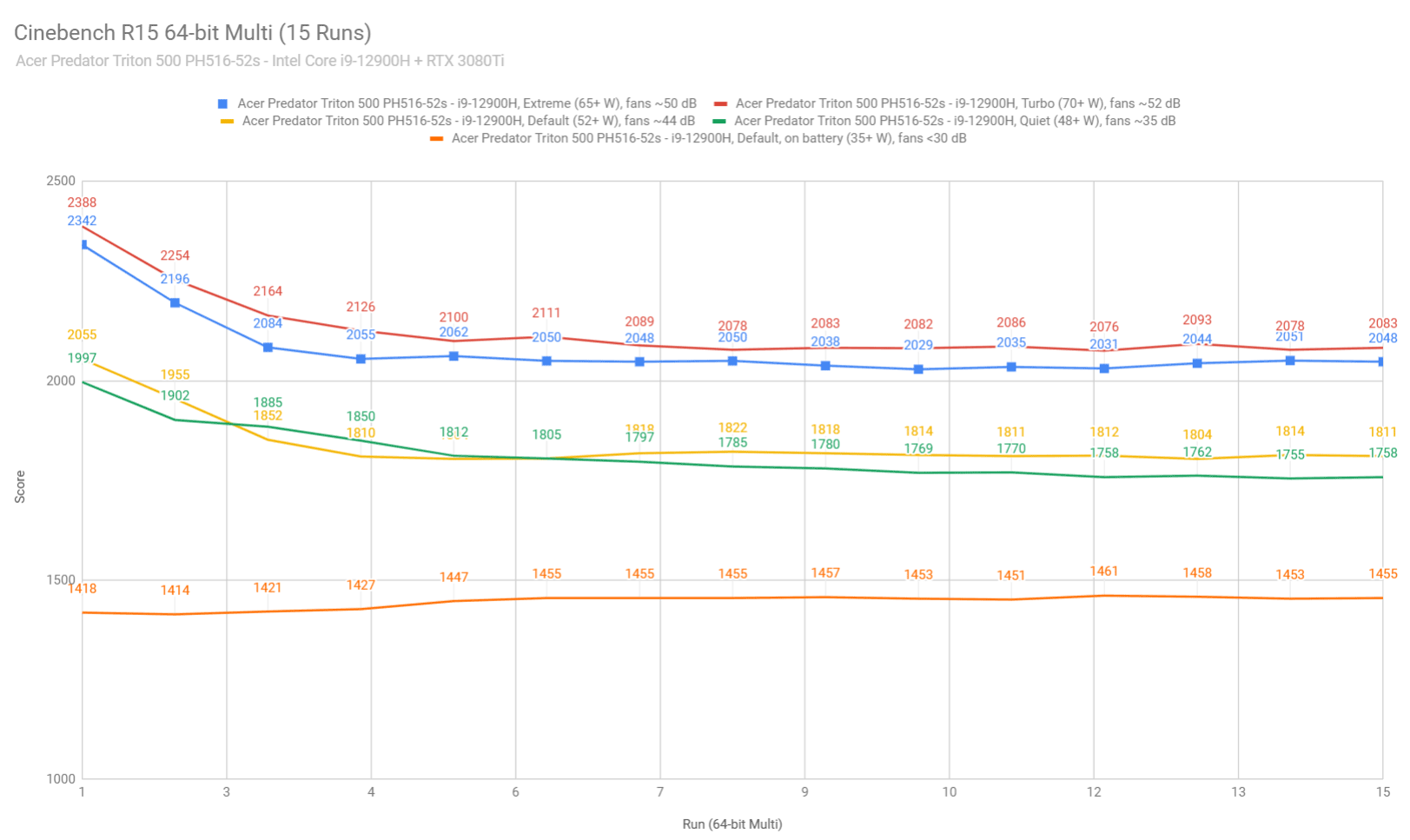
I then went ahead and further verified our findings with the more taxing Cinebench R23 loop test and Blender – Classroom, which resulted in similar findings to what we explained above.
Finally, we ran our combined CPU+GPU stress tests on this notebook. 3DMark stress runs the same test for 20 times in a loop and looks for performance variation and degradation over time. Our sample failed the test both on the Extreme profile with the laptop sitting on the desk, or on Turbo with the back raised up to improve the airflow into the fans.
Next, I ran a couple of tests and benchmarks, on the Turbo profile in Predator Sense and the dGPU set on Optimus. Take them with a lump of salt, though, as once more the final retail units might score differently, especially in the CPU tests.
With the current software, the system allows for up to 130W of combined CPU+ GPU power on the Turbo profile and applies a +100 MHz Clock/+100 MHz Memory overclock to the GPU. The reason I went with the Turbo profile and not with Extreme is the limited noise difference between the two (50 dB on Extreme, 53 dB on Turbo), the lower internal temperatures on the Turbo profile, and the fact that the Extreme profile doesn’t apply any GPU overclock with the current settings. Again, this might change with later BIOS updates.
Here’s what we got.
- 3DMark 13 – Fire Strike: 23868 (Graphics – 29103, Physics – 25499, Combined – 11136);
- 3DMark 13 – Port Royal: 6478;
- 3DMark 13 – Time Spy: 10981 (Graphics – 10923, CPU – 11323);
- Uniengine Superposition – 1080p Extreme: 6591;
- Uniengine Superposition – 1080p Medium: 20071;
- Handbrake 1.3.3 (4K to 1080p encode): 56.10 average fps;
- PassMark 10: Rating: 6041 (CPU: 28460, 3D Graphics: 17821, Memory: 2879, Disk : 41420);
- PCMark 10: 7245 (Essentials – 10417, Productivity – 9371, Digital Content Creation – 10571);
- GeekBench 5.4.3 64-bit: Single-Core: 1883, Multi-core: 12335;
- CineBench R15 (best run): CPU 2388 cb, CPU Single Core 269 cb;
- CineBench R20 (best run): CPU 5603 cb, CPU Single Core 715 cb;
- CineBench R23: CPU 14669 cb (best single run), CPU 13732 cb (10 min run), CPU Single Core 1845 cb;
- x265 HD Benchmark 64-bit: 29.44 s.
And here are some workstation benchmarks, on the same Turbo profile:
- Blender 2.93 – BMW Car scene- CPU Compute: 2m 54s (Turbo);
- Blender 2.93 – BMW Car scene- GPU Compute: 20s (CUDA), 12s (Optix);
- Blender 2.93 – Classroom scene – CPU Compute: 6m 47s (Turbo);
- Blender 2.93 – Classroom scene – GPU Compute: 40s (CUDA), 24s (Optix);
- Pugetbench – DaVinci Resolve: 1000;
- Pugetbench – Adobe Afert Effects: 941;
- Pugetbench – Adobe Photoshop: 1047;
- Pugetbench – Adobe Premiere: 937;
- SPECviewperf 2020 – 3DSMax: 118.77 ;
- SPECviewperf 2020 – Catia: 63.37;
- SPECviewperf 2020 – Creo: 88.97;
- SPECviewperf 2020 – Energy: 20.85;
- SPECviewperf 2020 – Maya: 300.14;
- SPECviewperf 2020 – Medical: 31.04;
- SPECviewperf 2020 – SNX: 20.28;
- SPECviewperf 2020 – SW: 212.62.
- V-Ray Benchmark: CPU – 9867 vsamples, GPU CUDA – 1271 vpaths, GPU RTX – 1446 vpaths;
I do expect the retail units to score 10-20% higher in the CPU multi-core tests, and there might be an improvement in GPU scores as well. Don’t expect wonders, though, as this design is only an 80-105W implementation, and not as powerful as the RTX chips in thicker notebooks.
Nonetheless, with the finalized software, the retail Triton 500 SEs should be fair performers for this class of portable designs.
Gaming performance
This laptop is still a Predator so we’re going to see how it handles modern titles. We tested several games at QHD+ and FHD+ resolution, on Ultra settings and several power profiles.
Once more, take these with a lump of salt. At this point, the MUX doesn’t properly work with the BIOS version that we have on this laptop. There is the option to select the dGPU Graphics mode in the Nvidia Control Panel and in the BIOS (hit Ctrl+S in the Advanced Section), but once I select the dGPU mode, nothing is displayed on the main screen anymore. Hence, I couldn’t properly test the dGPU mode. As a result, the gaming results down below are on the Hybrid/Optimus mode, with the signal routed through the iGPU, which takes a toll on the performance. I might be able to update at a later date, with the retail BIOS settings.
Still, in order to better help you understand what this laptop is capable of in the dGPU mode, I did test the Turbo profile connected to an external display through the HDMI 2.1 port, which offers a direct connection to the Nvidia dGPU. You should get similar results on this laptop’s main display with a properly working MUX setup. Just be aware of the resolution differences in the table. The internal screen is 16:10, while the external display used for the test is 16:9, hence it has about 12% fewer pixels to display.
Here’s what we got.
Intel Core i9-12900H
+ RTX 3080Ti Laptop 80-100W
QHD+
Turbo,
Optimus
QHD
Turbo,
external, dGPU
QHD+ Extreme,
Optimus
QHD+ Default,
Optimus
FHD+
Turbo,
Optimus
FHD
Turbo,
external, dGPU
Battlefield V
(DX 12, Ultra Preset, RTX OFF)
106 fps (48 fps – 1% low)
116 fps (38 fps – 1% low)
90 fps (47 fps – 1% low)
81 fps (46 fps – 1% low)
131 fps (53 fps – 1% low)
138 fps (45 fps – 1% low)
Cyberpunk 2077
(DX 12, Ultra Preset, RTX OFF)
36 fps (27 fps – 1% low)
–
34 fps (25 fps – 1% low)
31 fps (22 fps – 1% low)
54 fps (42 fps – 1% low)
–
Doom Eternal
(Vulkan, Ultra Preset)
126 fps (60 fps – 1% low)
150 fps (63 fps – 1% low)
116 (53 fps – 1% low)
102 (55 fps – 1% low)
185 fps (118 fps – 1% low)
213 fps (59 fps – 1% low)
Far Cry 6
(DX 12, Ultra Preset, TAA)
73 fps (38 fps – 1% low)
–
69 fps (35 fps – 1% low)
–
108 fps (46 fps – 1% low)
–
Far Cry 5
(DX 11, Ultra Preset, SMAA)
95 fps (75 fps – 1% low)
102 fps (68 fps – 1% low)
91 fps (72 fps – 1% low)
84 fps (65 fps – 1% low)
118 fps (83 fps – 1% low)
134 fps (82 fps – 1% low)
Red Dead Redemption 2
(DX 12, Ultra Optimized, TAA)
72 fps (42 fps – 1% low)
–
–
–
96 fps (48 fps – 1% low)
–
The Witcher 3: Wild Hunt
(DX 11, Ultra Preset, Hairworks On 4)
96 fps (64 fps – 1% low)
96 fps (35 fps – 1% low)
87 fps (61 fps – 1% low)
81 fps (55 fps – 1% low)
125 fps (78 fps – 1% low)
130 fps (41 fps – 1% low)
- Battlefield V, Cyberpunk, Doom, The Witcher 3 – recorded with Fraps/in-game FPS counter in campaign mode;
- Far Cry, Metro, Tomb Raider games – recorded with the included Benchmark utilities;
- Red Dead Redemption 2 Optimized profile based on these settings.
Those above are rasterization tests, and here are some results for RTX titles with and without DLSS.
Intel Core i9-12900H
+ RTX 3080Ti Laptop 80-100W
QHD+ Turbo, Optimus
FHD+ Turbo, Optimus
Battlefield V
(DX 12, Ultra Preset, RTX ON, DLSS OFF)
61 fps (41 fps – 1% low)
88 fps (58 fps – 1% low)
Battlefield V
(DX 12, Ultra Preset, RTX ON, DLSS ON)
72 fps (54 fps – 1% low)
102 fps (62 fps – 1% low)
Cyberpunk 2077
(DX 12, Ultra Preset + RTX, no DLSS)
–
–
Cyberpunk 2077
(DX 12, Ultra Preset + RTX, DLSS Balanced)
42 fps (31 fps – 1% low)
62 fps (47 fps – 1% low)
Doom Eternal
(DX 12, Ultra Preset, RTX ON, DLSS Quality)
109 fps (55 fps – 1% low)
152 fps (108 fps – 1% low)
Far Cry 6
(DX 12, Ultra Preset + DXR reflections / shadows)
59 fps (32 fps – 1% low)
72 fps (40 fps – 1% low)
Even when acknowledging the 16:9 vs 16:10 resolution, there is a performance difference in games between our unit running on Optimus and what you’ll end up on the retail models running on the MUX-dGPU mode. That’s about 5-15% at FHD-level resolution, and sub 10% at QHD-level resolution. However, with this laptop implementing Advanced Optimus with the ability to dynamically switch between the iGPU/DGPU display outputs, you’ll never have to change anything manually, the system will do it for you. Hopefully, without any bugs, as we’ve run into various quirks with Advanced Optimus in the past. Look for our update or check out other reviews for more details.
I’ve added a handful of HWinfo logs down below, for a better understanding of what the platform is capable of on the various power profiles.
The Extreme mode pushes the fans to about 85% of their rpms, which translates into fan noise of around 50 dB with games.
The CPU runs OK, with temperatures in the 80-85 degrees Celsius, but the GPU runs around the 87 C limit and ends up thermally throttled in most games. As a result, it cannot run at its designed 105W power limit with Dynamic Boost, but rather at 90-95W of power between the tested titles.
Otherwise, the air-admission design is pretty good here, and I haven’t noticed major differences in temperatures and performance when keeping the laptop on the desk or when raising the back to help the air admission into the fans. At the same time, given the higher internal GPU temperatures, I would recommend placing this laptop on a powerful cooling pad during long game sessions.
Activating the Turbo mode ramps the fans to 100% of their rpms, with noise levels of 53+ dB at head level.
Little changes in terms of internal CPU/GPU temperatures compared to the Extreme profile, but this mode allows superior gaming performance, both because it adds a GPU overclock, but also because it allows the GPU to run at a higher power of 95-103W. The high GPU temperatures are still a limitation, but on this Turbo mode the GPU ends up closer to performing at its maximum designed capacity.
And here’s what happens when you connect an external monitor through the HDMI port.
The Default mode tames down the fans to about 43 dB at head level, but also impacts the power settings and internal temperatures. The CPU runs in the 80-95 degrees Celsius on this mode, while the GPU stabilizes at the 87C thermal limit and 75-85 W of power.
I’d also consider running games on the Quiet mode, especially when looking for low fan noise.
In this case, the fans don’t go over 40 dB, and the performance is capped to 60 fps with Whisper Mode. As a result, the GPU ends up running at lower temperatures than on any of the other titles, especially if you opt for FHD-level resolutions and mid-level graphics settings.
Finally, you can also game on the Default mode unplugged from the wall. Framerates are capped to 60 fps in this case in titles such as Witcher 3, but will end up lower with more recent AAA games. Don’t expect more than one hour of gaming time.
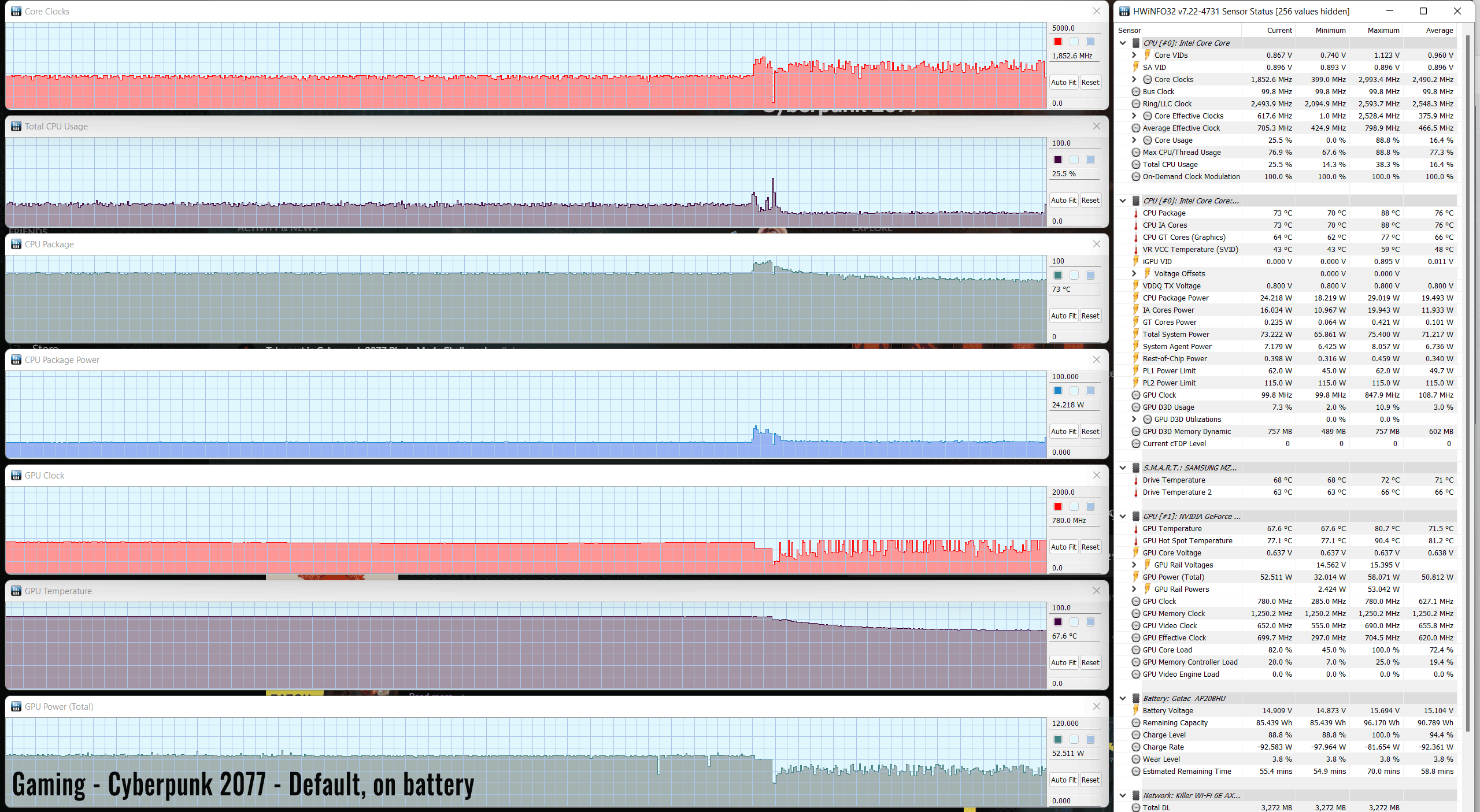
All in all, this Predator Triton 500 is a fair design for its portable segment, and while I can’t properly judge its abilities with the immature BIOS on our unit, I am concerned about the high GPU temperatures, despite the fact that the fans are ramping up loudly on the Extreme/Turbo modes. Even with proper BIOS on the retail units, this is only a mid-powered design so don’t expect it to match the performance or the thermal behavior of thicker products such as Predator Helios or even the Nitro lineups.
Noise, Heat, Connectivity, speakers, and others
Acer are using a tri-fan design on the 2022 Triton 500, with a multitude of heatpipes and liquid metal applied on the CPU (as a novelty over the previous generation). The inverted internal design prevents us from taking a closer look at the cooling module, as that would have required removing the motherboard. Image source.
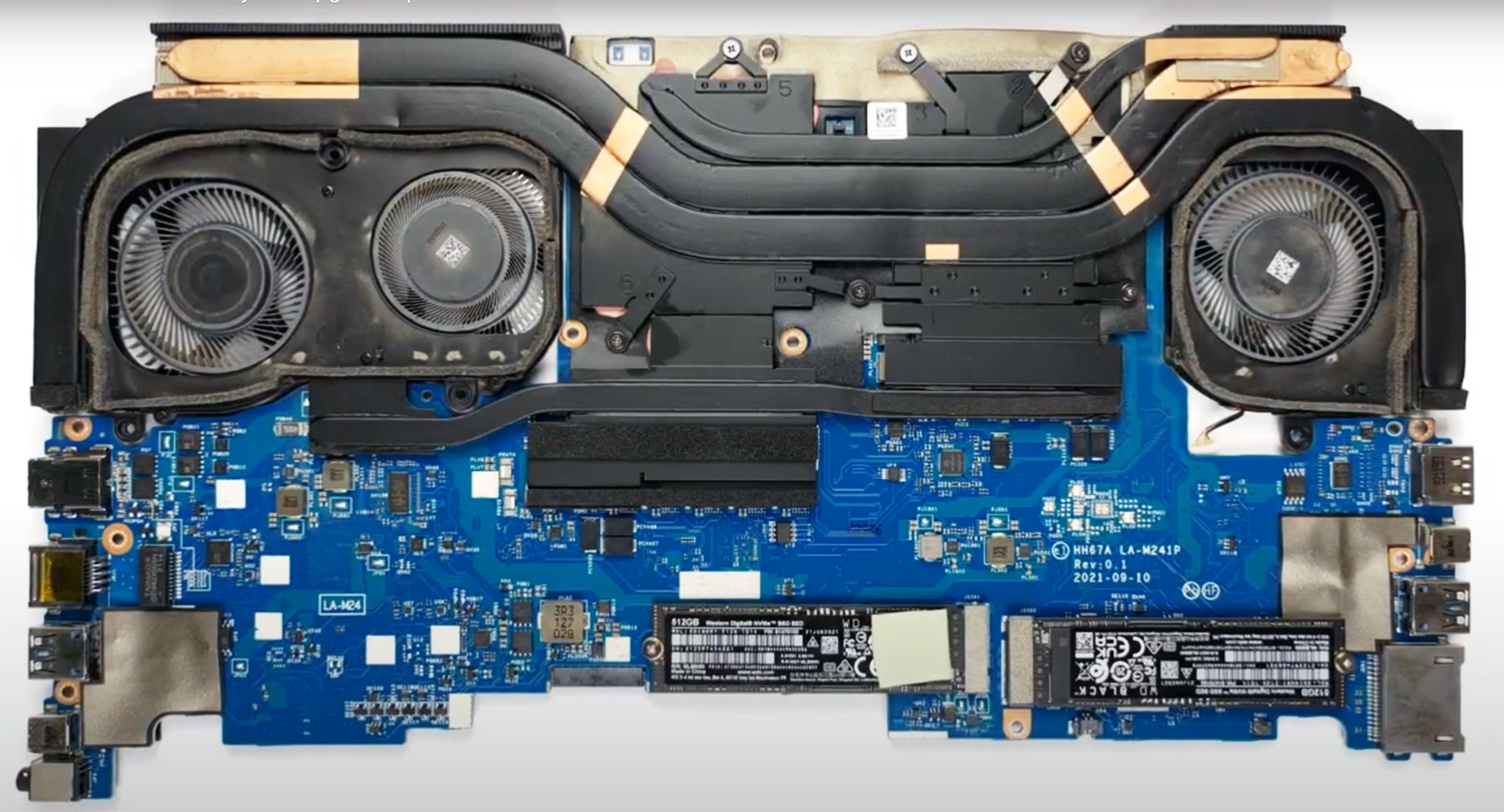
Fresh air goes inside this laptop through the vents on the top (above the keyboard) and the underside. I appreciate how Acer put a taller back-foot on the bottom of this laptop and made sure not to choke the airflow into the fans. Plus, the hot air is pushed out to the sides and the back, and not into the display, as with other portable units.
However, our findings on this early review unit aren’t great. The CPU is thermally limited in sustained CPU loads, and then the GPU is also limited in the GPU and combined loads, and unable to run at its peak designed settings in most cases.
You’ll pretty much have to rely on the Turbo mode in order to squeeze the best performance possible on this laptop, but that comes with very loud fans, at 53+ dB at head-level. Even the Turbo mode runs loud, at 50 dB, and while the Default profile keeps the fans at much more enjoyable levels of 43-44 dB, that’s with a significant toll in performance.
Of course, these findings might change on the retail units with later software, but I wouldn’t get my hopes too high, given what I’m seeing here and my experience with the 2021 Triton 500 SE model.
The external temperatures with games and demanding loads are mostly fine, though.

*Gaming – Extreme – playing Witcher 3 for 30 minutes, fans at ~50 dB
The laptop keeps quiet during daily use, with the fansstaying idle most of the time on the Quiet and Default modes.
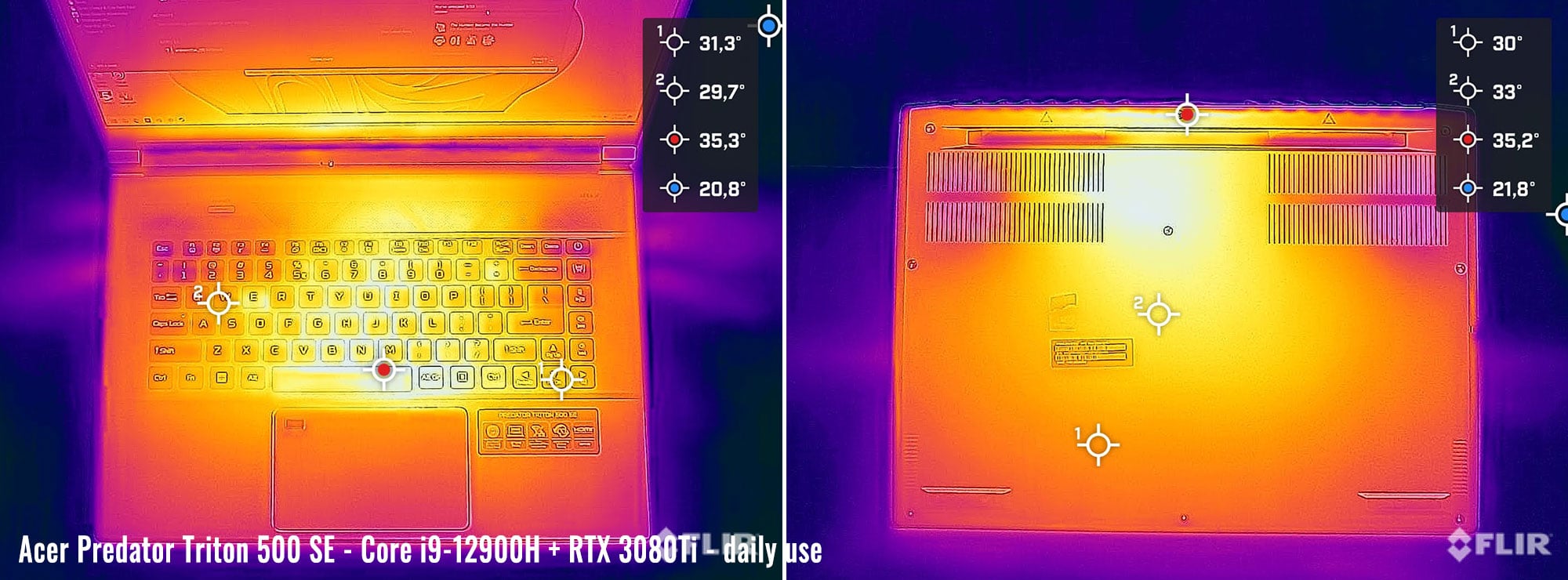
*Daily Use – streaming Netflix in EDGE for 30 minutes, Default profile, fans at 0 dB
For connectivity, there’s Wireless 6E and Bluetooth 5.2 on this unit, through a Killer Intel-based chip, as well as 2.5 Gigabit Lan, through a Killer Realtek chip. Both are faster implementations than what I’ve seen on most other 2022 laptops, and I hope Acer will offer the same chips in the retail models as well – there’s no guarantee with the current chip shortage, though.
Acer haven’t updated the speakers on the 2022 Predator Triton 500 from the previous generation, and I wish they would have.
They still put small speakers inside this laptop, and as a result, the audio lacks in both volumes and quality. I measured about 75-77 dB max levels, with the audio quality on the tinnier side, lacking in the lows. For what is worth, there’s no Enhanced Audio setting in Windows 11 on this unit, which has helped the audio delivery on other tested laptops. Perhaps it will be available and will help on the retail units.
Finally, there’s the camera. This is alright quality considering the low bar set by most other laptops these days, and is placed where it should be, at the top of the screen, flanked by microphones.
Battery life
There’s a 99Wh battery inside the 2022 Predator Triton 500 Helios 300, the largest possible in a laptop due to flight restrictions.
Here’s what we got on our review unit in terms of battery life, with the screen’s brightness set at around 120 nits (~50 brightness):
- 20 W (~5 h of use) – text editing in Google Drive, Default Mode, screen at 50%, Wi-Fi ON;
- 18 W (~5-6 h of use) – 1080p fullscreen video on Youtube in Edge, Default Mode, screen at 50%, Wi-Fi ON;
- 16 W (~6-7 h of use) – Netflix fullscreen in Edge, Default Mode, screen at 50%, Wi-Fi ON;
- 25 W (~4 h of use) – browsing in Edge, Default Mode, screen at 50%, Wi-Fi ON.
The system doesn’t automatically switch the screen’s refresh to 60 Hz when using the laptop on battery, so we ran our tests on the default 240Hz refresh. Manually opting for 60Hz would have a positive impact on the runtimes, corroborated with more mature software that should be available in the future. I’d especially expect an impact on video streaming and light use.
Acer ships the laptop with a mid-sized 230W charger. The series supports USB-C charging as well, up to 100W, if you don’t want to carry the main brick with you. Of course, you’re not getting full performance on USB-C power.
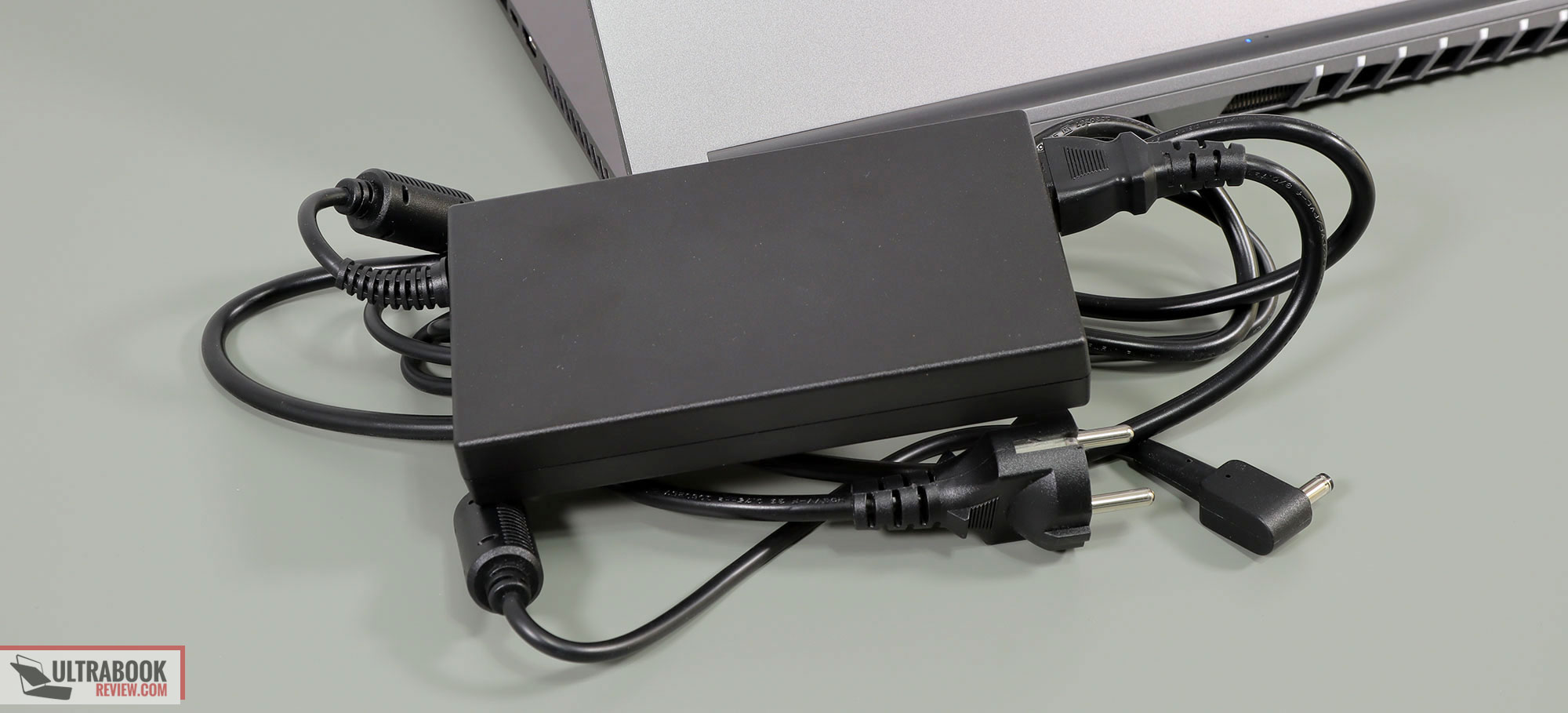
Price and availability- 2022 Acer Predator Triton 500
The 2022 Predator Triton 500 series is expected in stores around May of this year.
As of mid-April 2022, the Core i7-12700H + RTX 3080Ti + 16 GB RAM + 1TB SSD configuration is listed at 2999 EUR in Germany and a few other EU countries. No other versions are available, yet, though.
I’ve also yet to find these listed in North America or the UK. Last year’s Triton 500 has been competitively priced in the i7+RTX 3060 configuration at BestBuy, and I’m hoping this year will follow on the same pathway.
We’ll update you when we know more. In the meantime, follow this link for updated configurations and prices in your region at the time you’re reading this article.
Final thoughts- 2022 Acer Predator Triton 500 review
I can’t properly draw final conclusions on the performance capabilities of this Triton 500 given the issues I ran into on our sample, with the current pre-release BIOS and software.
I can, however, extrapolate based on the power settings and our experience with the platform tested in multiple other products. This way, expect the Triton 500 to be a snappy multitasker and a decent performer in combined tasks. I wouldn’t go for an i9 or an RTX 3080-class dGPU in this chassis – the limited power settings, corroborated with the somewhat limited thermal design, won’t make them justice and you’ll end up paying a whole lot extra for little performance gains.
Instead, the i7 + RTX 3060 is most likely the value spot here, if Acer will once more properly price those variations, as they did with the 2021 generation. Even with these specs, you’ll still have to accept the power limits and the high GPU internal temperatures, which would crave for a cooling pad during long game/work sessions, but the value proposition is better balanced than on the top-tier specs tested on our unit. Just make sure you’re getting the desired amount of RAM and storage, as upgrading the components on this laptop is a pain with the inverted design.
These aside, the mediocre audio quality is my other major nit with this series. Up to you how much this matters or not.
On the other hand, I appreciate the overall design and ergonomics Acer are offering with this Triton 500 SE product, the quality of the beautiful QHD+ 10-bit display, the comfortable inputs, the good IO, and the fact that they didn’t cut any corners with the battery inside. Too bad Intel Alder Lake is a hog, though, so don’t expect very long runtimes on battery, even with that big battery.
This pretty much wraps up my review of the 2022 Acer Predator Triton 500 SE PT516-52s model (that’s a mouthful). Looking for your thoughts, feedback, and questions on the series in the comments section down below.
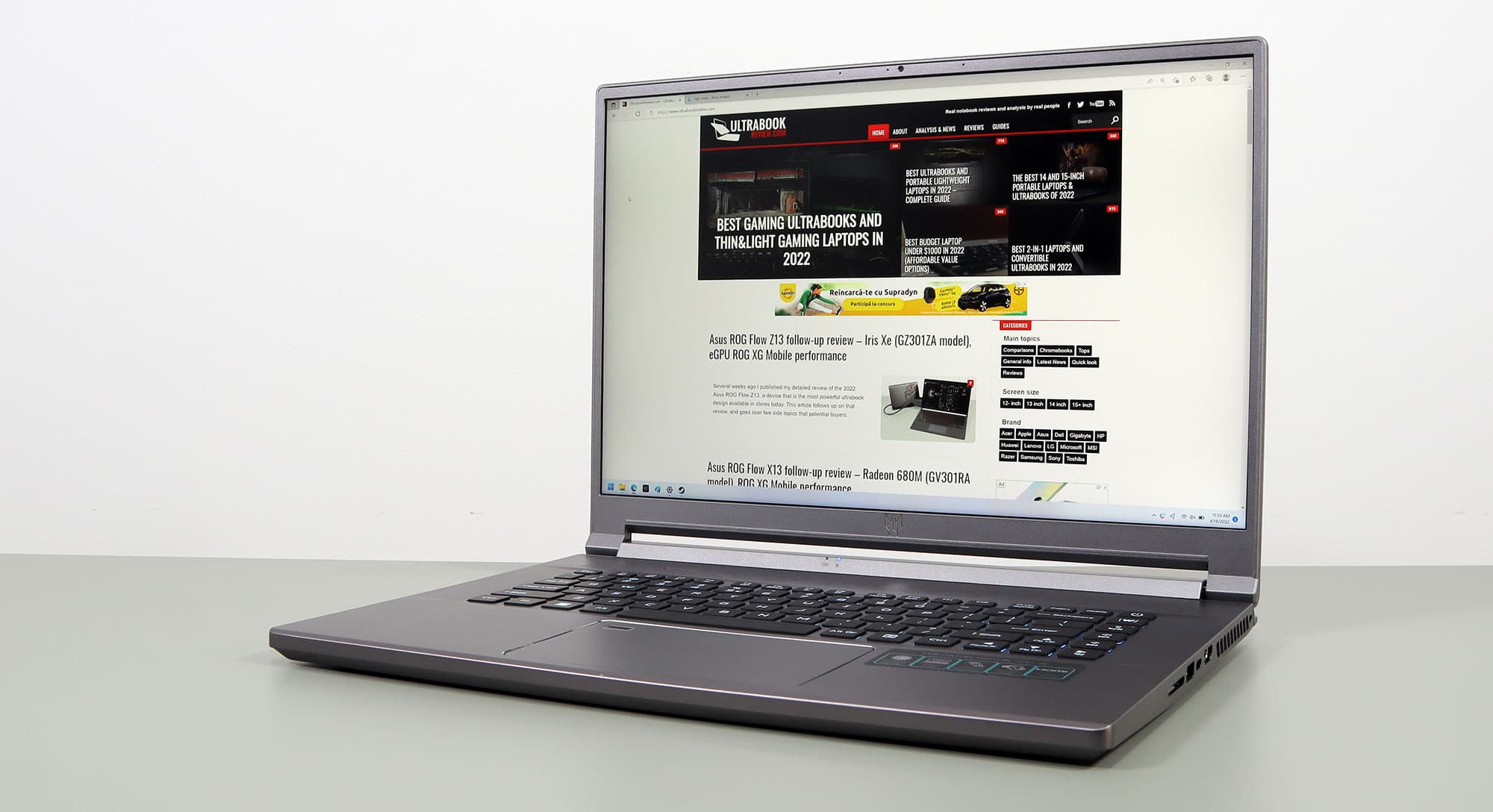
Disclaimer: Our content is reader-supported. If you buy through some of the links on our site, we may earn a commission.
Navigation: Ultrabookreview.com » 15.6 inch or larger
Our content is reader-supported. If you buy through some of the links on our site, we may earn a commission. Terms


Review by: Andrei Girbea
Andrei Girbea, Editor-in-Chief. I’ve a Bachelor’s in Computer Engineering and I’ve been covering mobile technology since the 2000s. You’ll mostly find reviews and thorough guides written by me here on the site, as well as some occasional first-impression articles.
. I’ve a Bachelor’s in Computer Engineering and I’ve been covering mobile technology since the 2000s. You’ll mostly find reviews and thorough guides written by me here on the site, as well as some occasional first-impression articles.







